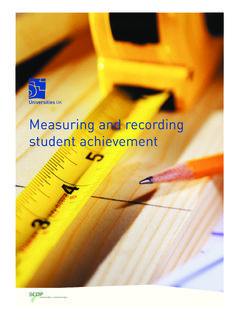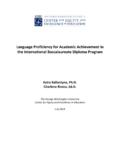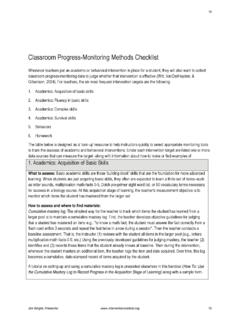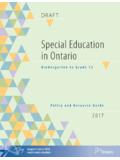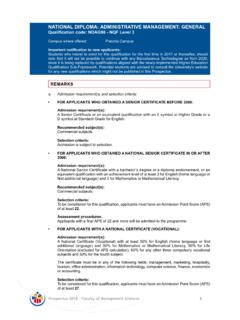Transcription of Study of Compensatory Tools and Dispensatory Devices in ...
1 IOSR Journal of Research & Method in Education (IOSR-JRME) e-ISSN: 2320 7388,p-ISSN: 2320 737X Volume 6, Issue 5 Ver. I (Sep. - Oct. 2016), PP 07-13 DOI: 7 | Page Study of Compensatory Tools and Dispensatory Devices in Italian Inclusive Education Valentina Della Volpe, (PhD Special Education)Italy Abstract: This paper looks at the issue of school inclusion by referring to the most recent laws about the inclusive education of students with special educational needs in Italy. Inclusive education means that all students attend and are welcomed by their neighbourhood schools in age-appropriate, regular classes and are supported to learn, contribute and participate in all aspects of the life of the education is about how we develop and design our schools, classrooms, programs and activities so that all students learn and participate together.
2 So ICT should be considered as a key tool for promoting equity in educational opportunities, that is using ICT to support the learning of learners with disabilities and special educational needs in inclusive settings within compulsory education. The paper also explore main educational and technological Tools which replaces or facilitate the performance required in the deficient ability of the students with SEN. Keywords:Inclusive education ICT Special Education Needs I. Introduction All students, have the right to have equal opportunity in education (EADSNE, 2010a; United Nations. 2006; UNESCO, 2009), and to be considered as being an integral part of the learning community.
3 Recognition of this right has recently given rise to the concept of inclusion , which in Italy has gradually substituted that of integration (Della Volpe, 2014; Canevaro, 2007). So Inclusive education - according to UNESCO- means that the school can provide a good education to all pupils irrespective of their varying abilities. All children will be treated with respect and ensured equal opportunities to learn together. Inclusive education is an on-going process. Teachers must work actively and deliberately to reach its goals (UNESCO, 2014). Inclusive education is: - a constantly evolving process of change and improvement within schools and the wider education system to make education more welcoming, learner-friendly, and beneficial for a wide range of people - about restructuring education cultures, policies and practices so that they can respond to a diverse range of learners - male and female; disabled and non-disabled; from different ethnic, language, religious or financial backgrounds; of different ages; and facing different health, migration, refugee or other vulnerability challenges.
4 - about changing the education system so that it is flexible enough to accommodate any learner; - an ongoing effort to identify and remove barriers that exclude learners within each unique situation; - about identifying and removing barriers to learners' presence in (access to) education, participation in the learning process, and academic and social achievement; - focused on solving attitude, practice, policy, environmental and resource barriers; - a process in which all stakeholders should participate (teachers, learners, parents, community members, government policy-makers, local leaders, non-governmental organizations, etc); - something that can happen outside the formal education system, as well as in formal school environments (inclusive education can happen in learning spaces that are non-formal, alternative, community-based, etc; with learners from young children through to elderly adults).
5 Inclusion is actually a much stronger concept which refers to the right to belong to the mainstream ; leaving behind the idea that only few learners have special needs , the social model of inclusion rather suggests that all students as individual learners present their own peculiar characteristics and have their own specific educational needs. Such a perspective implies a Copernican revolution which brings all students at the very heart of the educational process whilst the school is required to adjust and change in order to enable each of them to participate in the life of the school to the best of their abilities (de Anna, 2014a, 2014b, 2015; Mura, 2012).
6 Inclusion should, then, be regarded as a long-lasting process which requires time, effort, competence and strong conviction by all those involved in students education, first and foremost, by teachers (de Anna, 2014c). Study of Compensatory Tools and Dispensatory Devices in Italian Inclusive Education DOI: 8 | Page The key role of teachers in giving birth to and maintaining a truly inclusive classroom is unquestionable (de Anna, Gaspari, Mura, 2015), but such an important mission also requires that suitable, effective and barrier-free educational means should be employed.
7 From this perspective, ICT resources are promising; there are grounds for maintaining that they help most students overcome barriers to learning, thus increasing their school achievement, together with their autonomy, willingness and self esteem. Indeed, educational research provides strong evidence that: ICT is both a medium and a powerful tool in supporting inclusive practice. It provides wide-ranging support for communication, assisting many learners to engage with learning, including those who are hard to reach, and helps to break down some of the barriers that lead to under-achievement and educational exclusion (Becta, 2004, 2007; Della Volpe, 2016).
8 In the following, it is argued that use of ICT Tools can (may) help teachers to make effective their teaching in order to support all students full inclusion. We begin with an analysis of the most recent laws about the inclusive education of students with special educational needs in Italy, and then we explore main educational and technological Tools which replaces or facilitate the performance required in the deficient ability of the students with SEN. Italian Framework of School Inclusion In the month of January 2013, the Ministry of Education, University and Research published the Directive of 27 December 2012, entitled Intervention Tools for students with Special Educational Needs and territorial organization for school inclusion.
9 It is important because it provides a series of guidelines, already present in the European Union, completing, in essence, the Italian framework of school inclusion(MEUR, 2012). As is known, in fact, the Italian system was the first in Europe to introduce the mainstream education for all students with disabilities by the Law 104/92and it has recently reorganized the principles of the same, with the Guidelines of August 4, 2009 (MEUR, 2009). Then, following the law 170/10, issued the Guidelines of 12 July 2011, relating to the school inclusion of students with specific learning disorders or dyslexia, dysgraphia, dyscalculia and dysorthography.
10 Nowadays, with a new Directive, the Ministry of Education, University and Research provides organizational indications on the inclusion of those students who are not certifiable or with disabilities or with learning difficulties, but who have learning difficulties due to personal disadvantage, family and socio-environmental. With the terms Special Educational Needs (hereafter SEN) mean exactly: - students with disabilities; - students with learning difficulties; - students with socio-economic disadvantage, linguistic, cultural. In all these types, the Directive of 27 december 2012 extends the benefits of the above mentioned Law , namely the Compensatory Tools and Dispensatory Devices .










